
Kuntillet `Ajrud
is the modern name of an archaeological site in the northeastern portion of the
Sinai Peninsula, nearly 50 km (about 31 miles) south of Kadesh
Barnea, in Judean territory for that time. The datings of this site are from the end of the 9th
century BCE and the beginning of the 8th. The site was excavated by Ze’ev Meshel and a team from the
The building is at a crossroads of trade routes, some liken
it to a fortress, though this building does not represent the known fortresses
from the eleventh and tenth centuries BCE. It is also believed by some scholars
to be a shrine, due to the images, prayers and inscriptions, yet it lacks the
typical cult vessels of most shrines. The bulk of the pottery found was of
Judean origin, though some of the smaller pieces were from
The deities mentioned are YHWH, Baal, El and Asherah (Ashrth). The main building that was excavated contained
numerous paintings and inscriptions on the walls, doorposts and on pithoi shards. The iconography represented in the art work
is a Phoenician / Syrian style, by a number of different artists. The scripts
represented are those of Phoenician and/or Early Hebrew. Hebrew script
descended from the Phoenician and some scholars say that you cant differentiate
between the Phoenician and Early Hebrew.
Inscriptions are represented by the English transliterations
of the Phoenician / Early Hebrew letters. Periods represent the separations
between words that were not yet written into texts and inscriptions. “…”
represents missing letters and [ ] represent letters that the scholars are
confident would be there, based on known words or names in the context of the
inscription. The acute “`”
represents the letter r (ayin) and the apostrophe “’” represents the letter ` (alef). Please notice that the acute looks like a backwards
apostrophe.
1. Below is the first inscription from Pithos A, which is located above the heads and overlaps the crown
of the “Bes” figures.
…‘MR. ‘…H…K. ‘MR. LYHL[l’l]
WLYW`SH. W…BRKTh. ‘TKM. LYHWH. ShMRN.
WL’ShrTh.
Translation: …says, say to Yehallelel
and to Yoash and…I bless you by YHWH Shomron (
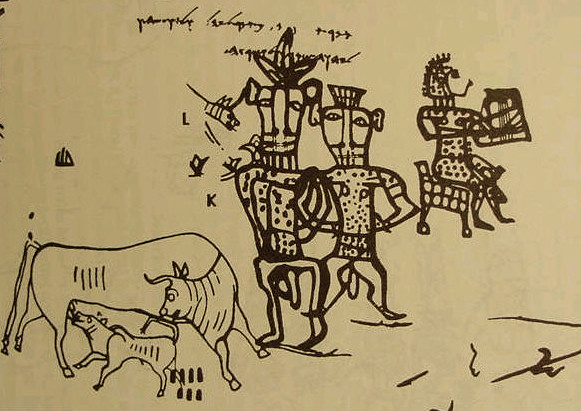
Most scholars, especially those that consider themselves
biblical archaeologists, explain this inscription as Yahweh and his consort
Asherah, yet biblical archaeologists have an agenda to find evidence to back up
the literalness of the bible and ignore anything that does not fit within that
box or try to explain it in the least damaging way. The image might help to
better explain what is going on with the inscription.
First, you see a cow with a suckling calf, which is a common
representation of the mother goddesses in several cultures, representing her
fertility and nurturing.
The middle figures are of the later Egyptian god Bes (Bisu), who was an apotropaic
figure, meaning that Bes warded off evil, protected households, especially
mothers and children, which you see represented by the cow and the suckling
calf. Originally Bes was strictly for the protection of the Pharaoh’s and as
the popularity grew, was adopted by the masses. Even later, Bes came to
represent pleasure and had a wife Beset. Some scholars believe that the oldest
representations of Bes were that of a lion rearing on its hind legs, which
explains the mane around the face and the hide, which came to be later
represented as a squatting being with a crown, beard and lion/leopard skin
clothing. The first Bes figure is male and the second, Beset, has the breasts
of a female, showing the pair together, wearing their skin clothing, with the
tails hanging between their legs. Below are three figures of Bes, showing the
lion characteristics, before they made him a dwarf. The first is from a headrest from 1200 BCE, the second is from
a cosmetic spoon dated to 1300 BCE and the third is from a cart for Tutankhamun about 1320 BCE. You can clearly see the mane,
ears and tail between his leg.
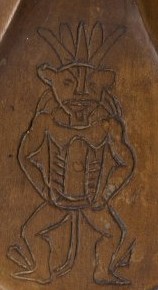
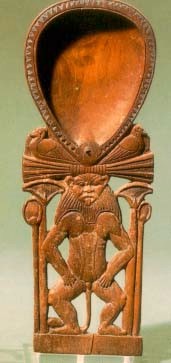
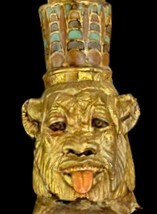
The third figure to the right, on Pithos A, is female, sitting on a feline throne, based
on the claw feet and spotted covering. Some scholars suggest that she is simply
a musician, but a musician would not be depicted on a lion throne chair, a sign
of royalty. Cultic artists took the standing form of the goddess who was shown
with either two great cats at her side, or standing on the back of one, then
eventually set her on a throne. Goddess thrones typically depict great cats on
the sides of the thrones, then eventually heads on or by the arms and finally a
chair with the feet and skin of a great cat. The images below are of the
Anatolian Kybele, the mother from Catal Huyuk and Arinna of the Hittites. The
final throne image is that of Tutankhamun’s,
elaborately made of gold, instead of covered with the animal skin depicted on
the pithoi shard. But, it does show the elements of
the original great cats that simply became represented in the furniture with
the claw feet.
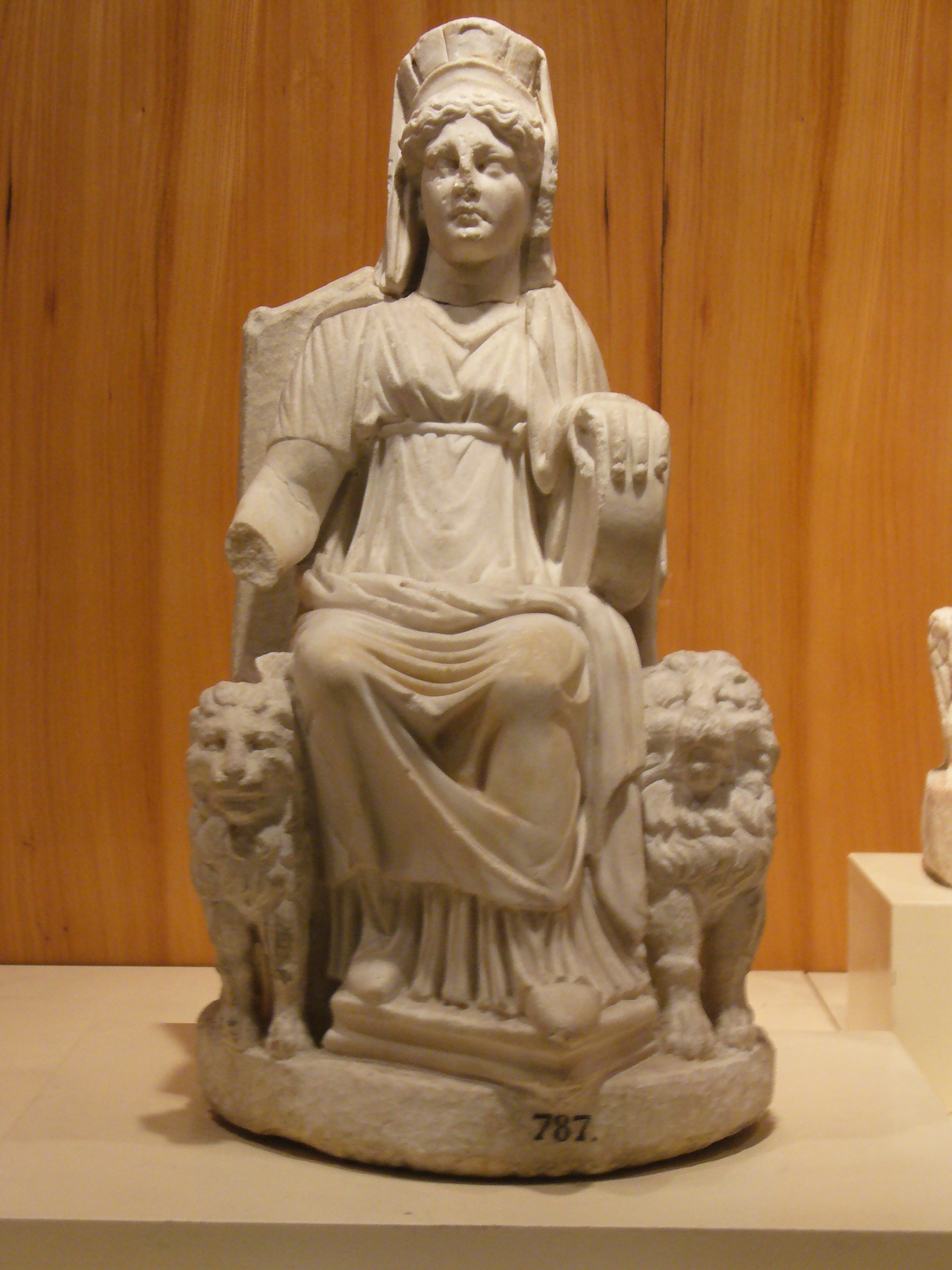
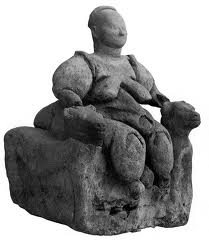
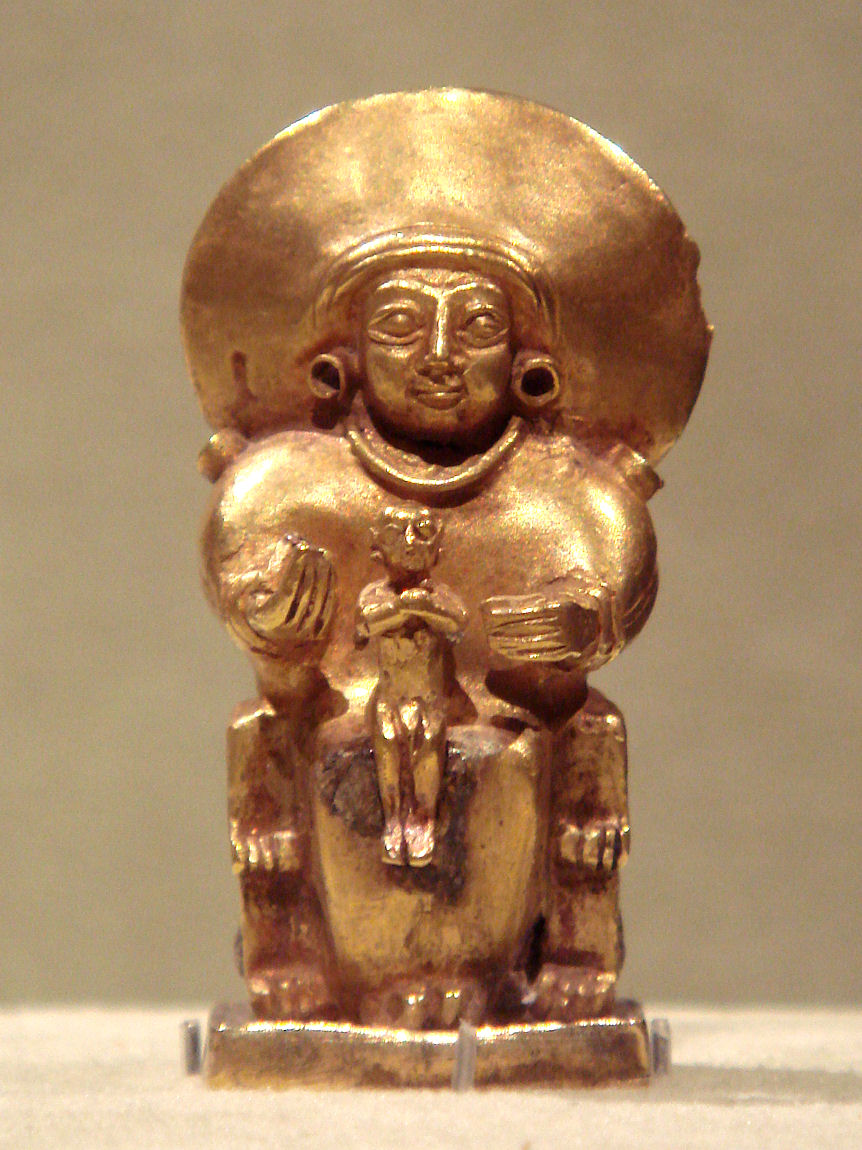
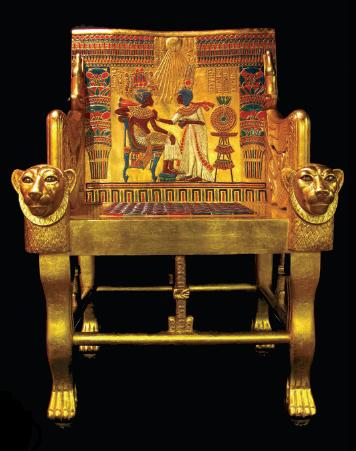
The image on the other side of Pithoi
A is below. You see the Tree of Life, a representation of the mother goddess
that feeds and sustains life.
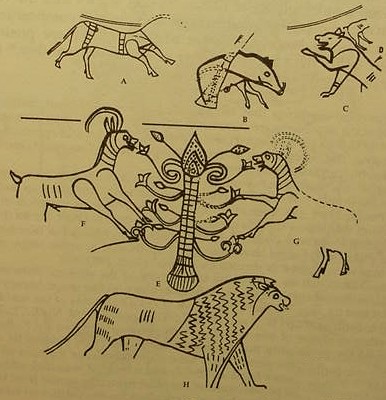
The typical caprids eating from
the Tree are on the sides. And the lion on which the goddess stands, is below
the tree. This imagery is very typical of statues and amulets of Asherah, Anat,
Astarte, Ishtar, Mistress of Animals (Athene), Qudshu
(Qedeshet), etc. First you see the goddess with
plants and the caprids, then eventually a tree
represents the goddess, with the caprids climbing the
tree for nourishment. 1. Mistress of Animals from Minet
el-Beida,
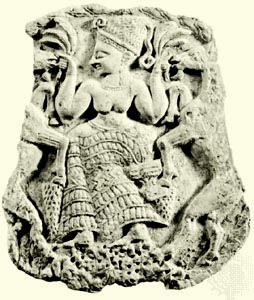

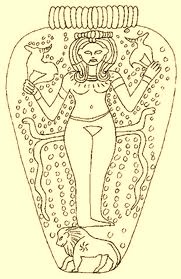
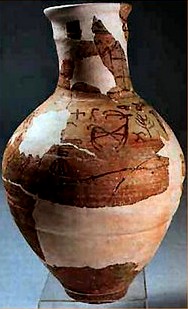
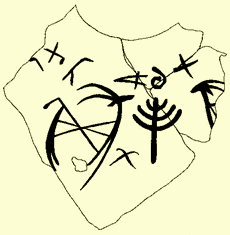
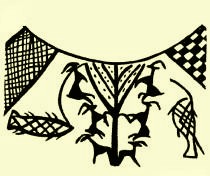
2. The second inscription is from Pithos B which shows a processional of
worshippers. The text reads:
‘MR ‘MRYW
‘MR L.’DNY HShLM. ‘Th BRKThK. LYHWH TMN WL’ShRTh. YBRK.
WYShMRK WYHY `M. ‘D[N]Y…K
Translation:
AmarYau says, speak to my lord, HShLM.
I bless you by YHWH of Teman and by Ashrth (Asherah). May he bless you and
observe you and be with my lord…
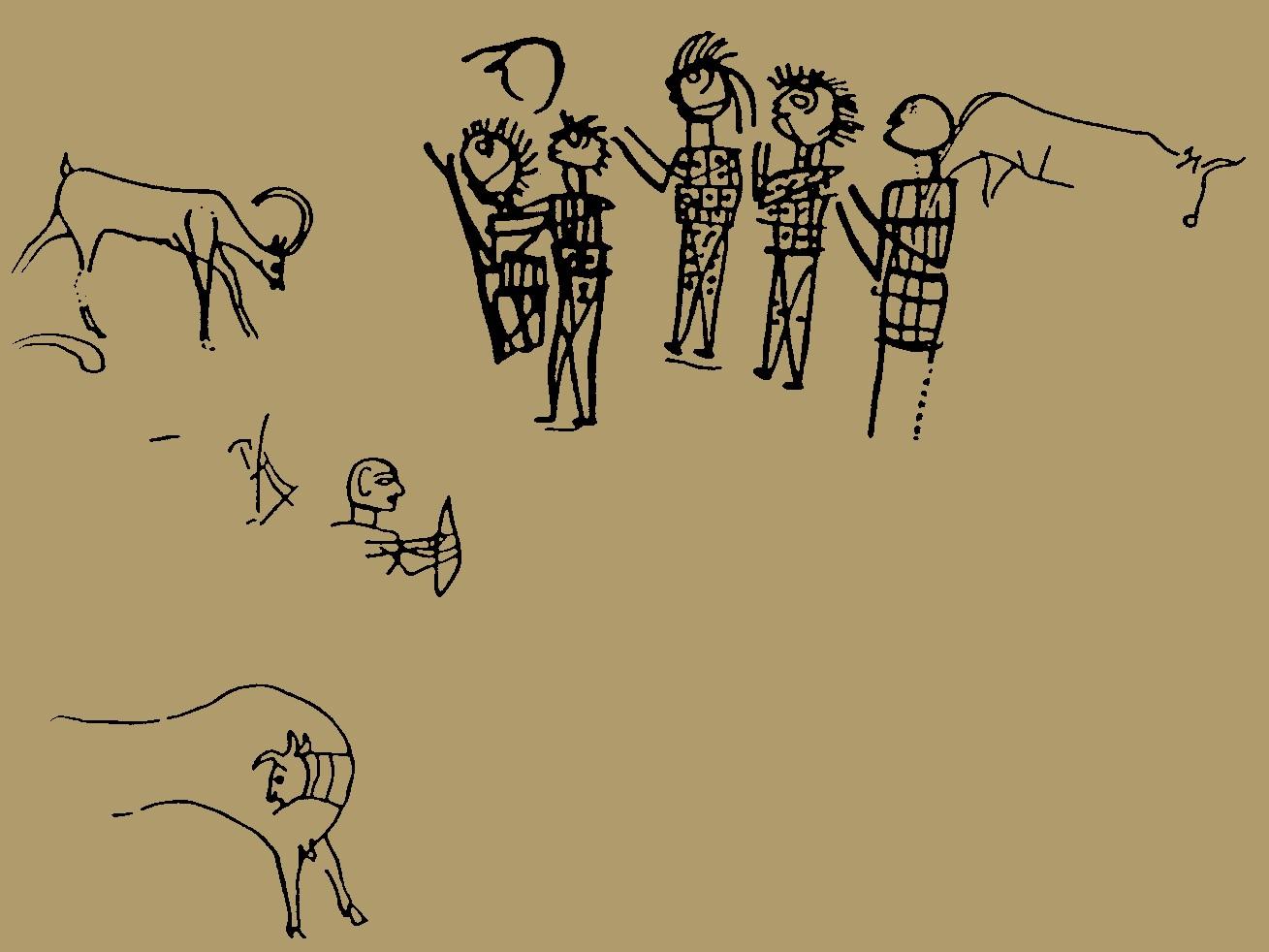
3. The
third inscription from Kuntillet Ajrud
that deals with YHWH and AShRTh is not on another pithoi, but is on plaster fragments that were originally on
the walls of the entry way and door
posts and fell to the floor. This is similar to the biblical injunction to
write the commandments on the doorposts
of the houses and on the gates – HaDebariym [Deuteronomy] 6:9.
The first
fragment: …’RK. YMM. WYShB `W…HYTB. YHWH…WY…
The
translation of the fragment is greatly varied by scholars, partially due to the
fragmentation and missing letters, but it basically amounts to a blessing of
long days and being satisfied, YHWH doing good to them.
The second
fragment from the doorway: …YTNW. L… ‘ShRTh
Translation:
they will or let them give to …AShRTh.
Now, you
may be asking, especially if you have seen any papers or books written up
on the subject, or online sources, why do I translate it as, “by YHWH and
by Asherah”, instead of the ever popular, by YHWH and HIS Asherah? That is
because there is no linguistic reason for the HIS. There is no pronominal
suffix showing possession for either his (e)
or hers / its (d) at the end of AShRTh.
Biblical archaeologists don’t want to admit to a goddess Asherah being worshipped,
much less alongside YHWH or as his consort, as in other religions. Other archaeologists
are trying to fit this into a patriarchal and sometimes monotheistic box,
so if they say, “and by his asherah”, they can make it an object, such as a wooden pole,
which is how they explain the Asherah in the
Below are several examples of multiple deities being listed
in a blessing, which is common when you have syncretism or consorts. In these
cases, they do not translate the second “L” before the second gods name as
being a possessive of the first god mentioned in the blessing.
In a Phoenician papyrus from Saqqara (in
In an Aramaic Elephantine Papyrus, from the 5th century
BCE, “BRKThK
LYHH WLKhN (M) – I bless you by YHH (an Elephantine
variant of YHW/Yahu) and by Khnum.”
Khnum was the other major deity, of Egyptian origina, in
As more examples come across my path, I will add them here
for comparison. I have three interlibrary loans on the ancient texts in Aramaic
and Phoenician that I will glean and see if there are more.
So why do translators translate these passages as, “by… and
by…” instead of the way they have translated the inscriptions concerning YHWH
and Asherah? Why the double standard? Do they feel that YHWH needs protecting
or the patriarchal priesthood religion perhaps? There are more questions that
these inscriptions raise.
For further comparison, please see the inscription from the
Khirbet
el-Qom Tomb.
Kathryn QannaYahu
